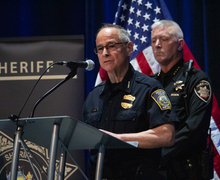Former vice chancellor and provost of Syracuse University brings ambition and idealism to the University of Dayton
Spencer Bodian | Staff Photograher
Spina started his career at SU in the L.C. Smith College of Engineering and Computer Science.
Editor’s Note: Several important Syracuse University officials are leaving their positions at the end of the academic year. Take a look at their stories in this four-part series.
Eric Spina had a choice to make. It was the mid-1990s and Spina, then a faculty member in the L.C. Smith College of Engineering and Computer Science at Syracuse University, had just received a job offer from the University of Texas. If he accepted the job, he would be a faculty member there, focusing on teaching and research.
But Spina wanted something more.
Once it became clear that he might be able to become an administrator at SU, the choice was simple. He turned down the offer.
“It was really that opportunity to be all parts of who I am: a teacher, a researcher and someone who serves others,” he said. “At the University of Texas, the expectation was that I was going to be in the lab doing research and that’s it.”
For the next 20 years Spina would rise within the administrative ranks, eventually becoming the second highest ranking official at SU, where he served for eight years. Now, he’s moving even further. Starting at the beginning of the 2016-17 academic year, he’ll be the president of the University of Dayton in Ohio. With him, Spina will take his self-professed optimism and his lofty ideals, attributes he said made him a good leader at SU.
Spina came to SU in 1988 as a faculty member in the College of Engineering. He became a top SU administrator in 2003 when he was appointed Douglas D. Danforth Dean of the College of Engineering. In 2006, he was appointed vice chancellor and provost — the chief academic officer of SU.
He stepped down from the position in 2014. At the time, he said it was to climb higher in the administrative ranks at another school, somewhere he could achieve his goal of becoming a college president. Although Spina has showed a willingness to become an administrator since the beginning of his career, he never planned to become a college president.
“I really didn’t have a plan, at no point at my career until a couple years ago did I think I might want to be a president,” he said.
In Spina’s mind, after he stepped down, there were three choices: go back to being a faculty member at SU or somewhere else — an option he already turned down once before, go somewhere else and be a provost or become a president. Spina chose the third option.
Spina knows he sounds idealistic when he talks about his tenure at SU. He knows that when he says — without missing a beat — his goal as vice chancellor and provost at SU was to see “dreams come true” it sounds a little naive and too optimistic. But he doesn’t have a problem with that.
“If we don’t have our sights set on the ideals — what can a university can be and what we want to make it — shame on us,” he said with a crooked smile, pushing up his thin wire glasses. “If we just think about all the problems we face, boy, I’m just going to stay in bed with the covers over my eyes.”
Spina said his idealism and his ability to lead isn’t enough to fix every problem in higher education, such as college accessibility, balancing the budget and administrative bloat. He does think it can help — and Spina said it did during times when he was dealing with “selfish” faculty or tirelessly asking alumni for money. Or during times when the university was in a state of upheaval.
Between the period of time when former Chancellor Nancy Cantor stepped down and when current Chancellor Kent Syverud was inaugurated, Spina served as interim chancellor. During that time, Spina said he tried to remain as apolitical as possible in a politically-charged environment. Keeping his idealism intact helped with that, especially during the transition between the two chancellors who are “two very different leaders,” Spina said.
And in fall 2014 when student demonstrators, part of THE General Body, staged a sit-in in Crouse-Hinds Hall — where Spina’s office was located — to protest the administration, Spina said he remained optimistic among fierce disagreement between administrators and protesters.
“Even though I didn’t agree with all of the things they wanted and the speed at which they wanted it done, I admired the passion of the students and I know they wanted to make the institution better,” Spina said. “There’s an idealism there that I absolutely respect.”
Published on May 2, 2016 at 10:57 pm
Contact Rachel: rsandler@syr.edu




